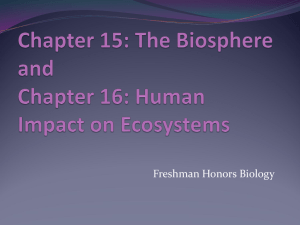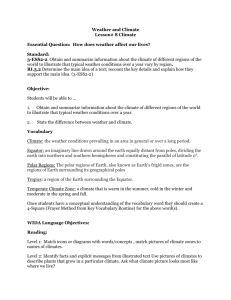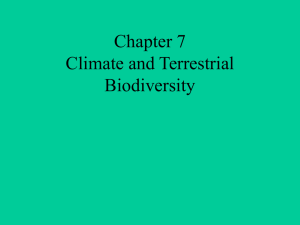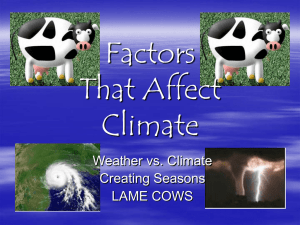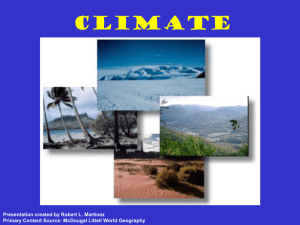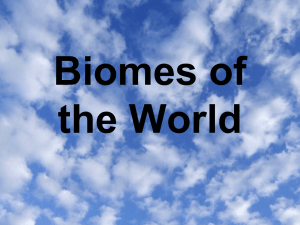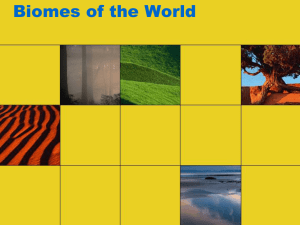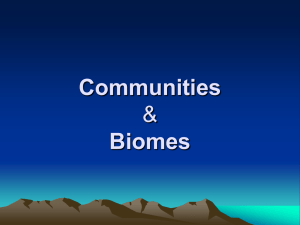Biomes
advertisement
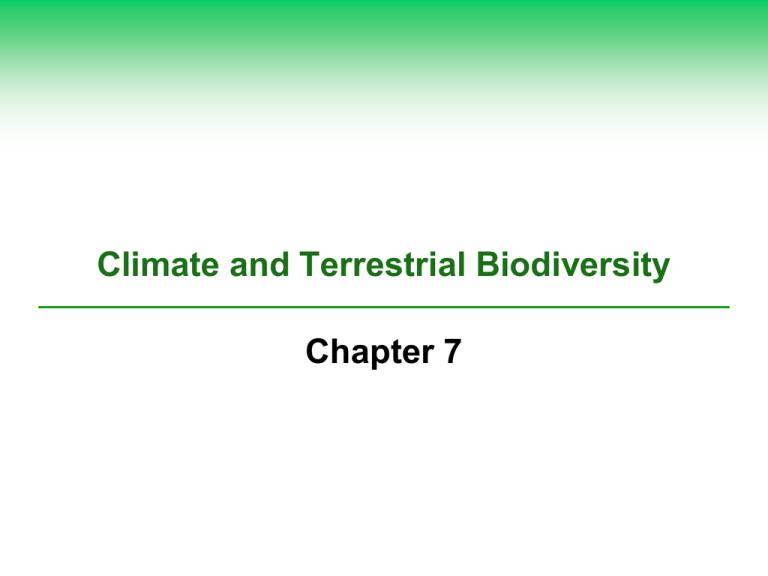
Climate and Terrestrial Biodiversity Chapter 7 7.1 The Earth Has Many Different Climates Weather – local area’s short-term temperature, precipitation, humidity, wind speed, cloud cover, etc. • Measured over hours or days The Earth Has Many Different Climates Climate – area’s general pattern of atmospheric or weather conditions • Measured over long periods of time The Earth Has Many Different Climates Climate - varies over different parts of the earth • Uneven heating of the earth’s surface by the sun • Rotation of the earth on its axis • Properties of air, water, and land Earth’s Atmosphere Tropics – air is warm Equator – 30o N/S Earth’s Atmosphere Polar regions – air is cold 60o - 90o N/S Convection Currents Up-and-down movement of air due to temperature differences Convection Currents Rule: Hot air rises and cold air sinks. Equator • Hot air rises and heads toward the poles Convection Currents Rule: Hot air rises and cold air sinks. Poles • Cold air rushes in to fill the space at the equator Figure 6.5 Wind Horizontal movement of air Convection Currents + Earth’s Rotation Equator Coriolis Effect Earth rotates and causes circulating air to be deflected Causes things thrown in straight line to move to the right or left (depends on hemisphere) Imagine a merry-go-round… Suppose you (represented by the dark blue circle) and a friend (represented by light blue circle) are on a merry go round. You gently toss a ball towards your friend The ball doesn’t actually get there! Coriolis Effect Summary Causes moving objects on Earth to follow curved paths • Northern Hemisphere – follows a path to the right of its intended target • Southern Hemisphere – follows a path to the left of its intended target Acts on all moving objects Your Turn! Deflected Activity Global Wind Patterns Prevailing Winds Major wind patterns on the Earth Direction caused by: 1. Convection currents 2. Earth’s rotation from west to east 3. Air pressure Global Air Circulation Wind Belts Doldrums • Between 5 degrees North and 5 degrees South latitude • Winds are calm Wind Belts Trade Winds • Historically: Used by ships traveling between Europe and the Americas • 5o-30o North and South of the Equator Trade Winds Northern Hemisphere • Warm air around the equator rises and flows north toward the pole • Earth’s rotation deflects air toward the right Trade Winds Southern Hemisphere • Similar pattern • Winds blow from the southeast toward the northwest • Descend near 30 degrees South latitude Wind Belts Westerly Winds • Remaining air (air that does not descend at 30 degrees North or South latitude) continues toward the poles Wind Belts Polar Easterlies • Cool air sinks and moves towards the equator • Air is deflected by Earth’s rotation Winds Drive Surface Ocean Currents! Global winds drag on the water’s surface • Cause water to move and build up in the direction that the wind is blowing Natural Capital: Generalized Map of the Earth’s Current Climate Zones Your Turn! Coastal Upwelling Climate and Biomes Biotic and Abiotic Factors Biotic Factors • Biological (living) influences on an organism within an ecosystem • Predators • Prey Abiotic Factors • Physical (non-living) factors that shape ecosystems • Temperature • Precipitation • Humidity What is a biome? Terrestrial community that covers a large area and is characterized by certain soil and climate conditions • Particular assemblages of plants and animals. Biomes Variations in plants and animals help different species survive under different conditions in different biomes. Tolerance - ability to survive and reproduce under conditions that differ from their optimal conditions The Major Biomes 60°N 30°N 0° Equator 30°S 60°S Tropical rain forest Tropical dry forest Tropical savanna Tundra Temperate grassland Temperate fore Northwestern Desert coniferous fore Boreal forest Temperate woodland (Taiga) and shrubland Mountains and ice caps Biomes Large terrestrial regions characterized by similar climate, soil, plants, and animals • Location irrelevant Biomes Not uniform; consist of a mosaic of patches with different biological communities Generalized Effects of Elevation and Latitude on Climate and Biomes Natural Capital: Average Precipitation and Average Temperature as Limiting Factors Your Turn! Biome Jigsaw Biome Bags Global Air Circulation, Ocean Currents, and Biomes Energy Transfer by Convection in the Atmosphere Heat is absorbed and released more slowly by water than by land • Moderate weather and climate of nearby lands Biomes and Climate The climate of a region is an important factor in determining which organisms can survive there. • Temperature and precipitation can vary over small distances. • Microclimate - the climate in a small area that differs from the climate around it The Earth’s Surface Features Affect Local Climates Cities • Microclimates • More haze and smog • Higher temperatures • Lower wind speeds • Causes • Bricks, asphalt, and concrete absorb and hold heat • Buildings block wind flow The Earth’s Surface Features Affect Local Climates Mountains • Rain shadow effect: moist air blowing inland is forced upward; cools and expands • Loses most of its moisture as rain or snow on the windward slope • Air dries and warms over leeward side; increases ability to hold moisture and dries ecosystem Climate Terms Tropical – warm; receives direct or nearly direct sunlight year round Desert - dry Temperate – moderate Climate Graphs of Three Types of Deserts Climate Graphs of Tropical, Temperate, and Cold Grasslands Chaparral Vegetation in Utah, U.S. Climate Graphs of Tropical, Temperate, and Cold Forests Stratification of Specialized Plant and Animal Niches in a Tropical Rain Forest Major Human Impacts on Terrestrial Ecosystems Tundra Taiga See Clip Tropical Rain Forest Temperate Forest Temperate Grassland Desert Chaparral

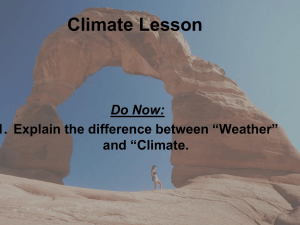
![Variations in the Physical Environment I & II [Lectures 7, 8]](http://s2.studylib.net/store/data/010107091_1-d990eec34f58884a24927e50a2f01731-300x300.png)
